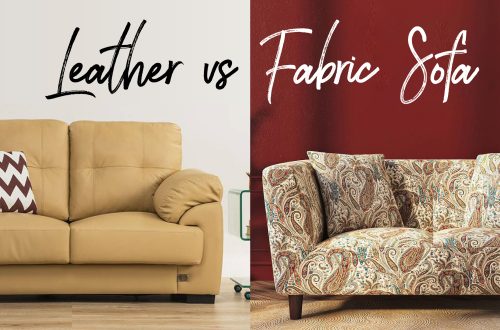The sofa is undeniably the centerpiece of most living rooms. It’s where we relax after a long day, entertain guests, and spend countless hours with family. However, this central role also makes it one of the most susceptible pieces of furniture to dirt, stains, and wear.
Whether it’s from daily use, accidental spills, or pet hair, sofas accumulate dirt and stains that can affect both their appearance and hygiene. Regular cleaning not only maintains the sofa’s aesthetic appeal but also extends its lifespan and ensures a healthier living environment for you and your family.
This comprehensive guide will walk you through the essential steps to clean your sofa effectively, regardless of its material. From preparation to execution, we’ll cover everything you need to know to restore your sofa to its pristine condition.
Before You Start: The Prep Work
Identifying the Material
Different sofa materials require different cleaning approaches. Before you begin, identify your sofa’s material to avoid damage:
- Fabric Sofas: Include cotton, linen, polyester, and blends. These are the most common and can often be cleaned with water-based solutions.
- Leather Sofas: Require special care to maintain their suppleness and prevent cracking. Need pH-balanced cleaners.
- Microfiber Sofas: Synthetic material that’s stain-resistant but can be damaged by harsh chemicals.
- Velvet Sofas: Delicate material that requires gentle cleaning to maintain the pile direction.
Pro Tip: Check the manufacturer’s label, usually found under the seat cushions or on the side of the sofa. It contains valuable information about the material and cleaning instructions.
Understanding Cleaning Codes
Most sofas come with a cleaning code that indicates the appropriate cleaning method:
- W (Water-based cleaner): Can be cleaned with water-based upholstery cleaners or mild detergent solutions.
- S (Solvent-based cleaner): Should be cleaned with dry cleaning solvents only. Avoid water-based products.
- W/S (Water or Solvent): Either water-based or solvent-based cleaners are safe to use.
- X (Vacuum or brush only): Should only be cleaned with vacuuming or light brushing. No liquids or chemicals.
Warning: Ignoring the cleaning code can void your warranty and cause irreversible damage to your sofa. Always check this before applying any cleaning solution.
Necessary Tools and Cleaning Solutions
Gather these essential tools before you begin:
- Vacuum Cleaner: With upholstery attachment for removing loose dirt and debris.
- Soft-Bristled Brush: For gentle scrubbing without damaging fabric.
- Microfiber Cloths: For blotting and drying without leaving lint.
- Cleaning Solutions: Appropriate for your sofa’s material and cleaning code.
- Spray Bottle: For even application of cleaning solutions.
- Protective Gear: Gloves to protect your hands during cleaning.
For specific materials, you’ll need specialized products:
- Fabric Sofas: Mild detergent, upholstery cleaner, or DIY solution of mild soap and water.
- Leather Sofas: Leather cleaner and conditioner to maintain suppleness.
- Microfiber Sofas: Specialized microfiber cleaner or mild detergent solution.
Step-by-Step Cleaning Guide
Vacuuming Loose Dirt and Debris
This is the most crucial first step in any sofa cleaning process:
- Remove all cushions and vacuum them separately, paying attention to seams and crevices.
- Use the upholstery attachment to vacuum all surfaces, moving in the direction of the fabric grain.
- Pay special attention to corners, seams, and crevices where dirt accumulates.
- For fabric sofas, use a soft brush attachment to lift embedded dirt.
- For leather sofas, use a dry cloth attachment to avoid scratching the surface.
Pro Tip: Vacuum your sofa weekly to prevent dirt buildup and make deep cleaning sessions more effective.
Spot Treatment for Stains
Address stains immediately for the best results:
- Blot, Don’t Rub: Use a clean cloth to blot spills immediately. Rubbing pushes stains deeper into fibers.
- Test First: Apply any cleaning solution to an inconspicuous area to test for colorfastness.
- Work from Outside In: Clean from the outer edges of the stain toward the center to prevent spreading.
Common stain solutions:
- Food Stains: Mix equal parts white vinegar and water. Blot gently and rinse with clean water.
- Oil-Based Stains: Sprinkle cornstarch or baking soda to absorb oil, then vacuum. For set stains, use a dry cleaning solvent.
- Ink Stains: Dab with rubbing alcohol using a cotton ball, working from the outside in.
- Pet Accidents: Blot immediately, then clean with an enzyme cleaner designed for pet stains.
Overall Cleaning Methods for Different Materials
Fabric Sofas (W or W/S Code)
- Mix a solution of 1/4 teaspoon mild detergent in 1 cup of warm water.
- Spray lightly on the sofa, avoiding oversaturation.
- Gently scrub with a soft brush in circular motions.
- Blot with a clean, damp cloth to remove soap residue.
- Use a dry cloth to absorb excess moisture.
Leather Sofas
- Wipe with a damp cloth to remove surface dirt.
- Apply leather cleaner with a soft cloth using circular motions.
- Allow to dry completely (2-3 hours).
- Apply leather conditioner to maintain suppleness and prevent cracking.
Microfiber Sofas
- Use a microfiber-specific cleaner or mild detergent solution.
- Apply with a spray bottle and gently scrub with a soft brush.
- Avoid harsh chemicals that can damage the fibers.
- Blot with a clean cloth and allow to air dry.
Drying and Fluffing the Cushions
Proper drying is essential to prevent mold and maintain cushion shape:
- Allow the sofa to air dry completely before use.
- Use fans to speed up the drying process if needed.
- Fluff cushions regularly to maintain their shape and comfort.
- Rotate cushions periodically to ensure even wear.
Warning: Never use a hair dryer or direct heat source to dry your sofa, as this can cause shrinkage, fading, or damage to materials.
When to Call a Professional
Some situations require the expertise of professional sofa cleaners:
- Deep Stains: Set-in stains like red wine, blood, or ink that don’t respond to home treatments.
- Extensive Soiling: Sofas that haven’t been cleaned in over a year and have accumulated significant dirt.
- Valuable or Delicate Sofas: Antique, designer, or delicate material sofas that require specialized care.
- Odor Removal: Persistent odors from pets, smoke, or cooking that penetrate deep into the fabric.
- Allergy Concerns: Professional cleaning can remove allergens that regular vacuuming can’t eliminate.
Professional sofa cleaning typically costs between ₹1,000-5,000 depending on size and condition, but it can extend your sofa’s life by several years.
Conclusion
Cleaning your sofa doesn’t have to be a daunting task when you have the right knowledge and approach. Regular maintenance through vacuuming and immediate spot treatment of spills can significantly reduce the need for deep cleaning sessions.
Remember that the key to successful sofa cleaning lies in understanding your sofa’s material and following the manufacturer’s cleaning instructions. Using the wrong cleaning method or products can cause irreversible damage, so always check the cleaning code before proceeding.
Whether you’re dealing with everyday dirt, accidental spills, or seasonal deep cleaning, this guide provides you with the tools and knowledge to keep your sofa looking its best. By following these steps and maintaining a regular cleaning schedule, you’ll ensure that your sofa remains a beautiful and comfortable centerpiece in your living room for years to come.
Investing time in proper sofa care pays dividends in both appearance and longevity. With the right techniques and a bit of effort, you can restore your sofa to its original condition and create a cleaner, healthier living environment for your family.





